Porcelain Insulator News
by Elton Gish
Reprinted from "Crown Jewels of the Wire", March 1996, page 24
The Value Guide for Unipart and Multipart Porcelain Insulators that I
introduced last year has met with very good success. About 200 have found their
way into collector’s hands. The book could not have been written without the
help of about 30 collectors who donated large amounts of time and energy
cataloging their collection and answering my surveys and follow-up questions. I
was totally surprised and amazed at the willingness of each person to
participate in the surveys. We made every effort to show in the book accurate
estimates of quantity available for a number of rare insulators; however a few
rare insulators reported many years ago in ‘Porcelain Insulator News” were
not reported this time. Also several other interesting items were brought to
light. This month I will report a few of these.
First we will discuss the super rare insulators that were not reported in the
surveys. I would like to know what happened to these insulators, so please
report them if either you have them or you know who does. I know that there are
major porcelain collectors out there who I either did not know about or forgot
to send a survey. Also some rare insulators could be sitting on shelves of
collectors who do not collect porcelain insulators as a primary interest.
No one reported having U-67. Lew Hohn reported this style with Fred Locke
marking many years ago; however, he does not remember who he sold it to. He said
that a bottle digger friend found two (I guess in the New York area). He traded
one to Lew and kept the second one. Surely someone in the hobby has the one that
belonged to Lew.

Jack Tod had the only known U-188 with the recess embossed marking AMERICAN
ELEC. CO. INC. (front side) and PATENT PENDING (back side). This was the
original mold set (circa 1925) marking for the dry process Square D “dry-spot”
insulator. Jack sold all of his insulators about 10 years ago.
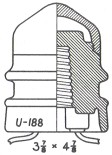
U-552 with NEW LEXINGTON, O. marking was not reported. This super classic
marking is unique to extremely rare on any style of insulator with exception of
U-746. It is only moderately rare for that style where perhaps one dozen marked
specimens are known.

U-705 with LIMA, N.Y. marking was reported many years ago with the U-552 N-L,
but no one reported it this time. Lima markings are rare for any style.
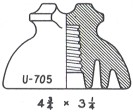
Please let me know if you
have any of these four insulators.
There were many surprises from the surveys, and it was interesting to
inventory the rare insulators. One unusual report was Bob Berry’s (NIA #1203)
unmarked U-937. These were made by Imperial Porcelain Works for the Niagara
Falls-Buffalo line that was put into service in November 1896. All of the eleven
other reported specimens have the #1 Imperial marking (no “crown logo”). Ken
Willick (NIA #3709) recently found a “new” specimen and had it at his table
at the London show.
A second U-938 Imperial was reported. These have the typical shiny tan/brown
Imperial glaze from circa 1902-1904. There are four ribs under the top skirt
similar to CD 315 and CD 321. Two more U-924’s showed up to make a total of
three (see Nov. 1994 Crown Jewels of the Wire). These white insulators have the
#1 Imperial marking. Three more U-923B’s were reported to make a total of
four. These early dry process insulators with embossed (raised) Fred Locke
marking #2-1 in the cross-top grooves were made by Thomas circa 1894-95. It was
also discovered that Jack Tod’s drawing for U-923C was actually made from an
unmarked specimen. Marked specimens, with embossed (raised) Fred Locke marking
#2-1 in the cross-top grooves, have a slightly different profile. The unmarked
specimens appear to be more rare. Remember that “embossed” is seldom
accurate when describing markings on porcelain insulators because that refers to
raised letters/numbers as is typical on glass insulators. Most markings on
porcelain insulators are “incuse” markings where the letters/numbers are
struck or indented into the surface.
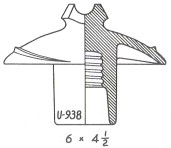
A brown U-560 with Imperial “crown logo” was reported for the first time.
Rick Tyler recently reported a white insulator with the Imperial marking #11.
The manufacturing date is very difficult to read. My best guess for the date is 8-23-98. This is the first time that I have seen a manufacturing date without
the “crown logo” marking. For a long time I thought this was a new style
until I realized that it was actually U-560. Two other white Imperial U-560’s
were reported on the Value Guide survey. A second U-940B was recently reported
by Chris Hedges (NIA #15).
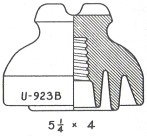
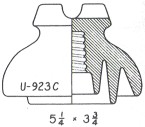
Chuck Dittmar (NIA #2910) reported two rare insulators. One is a white U-939D
with Fred Locke under-glaze ink marking - the second one known. The under-glaze
ink marked specimens were made by Electric Porcelain & Mfg. Co. for Fred
Locke circa 1897-1900. More significant is Chuck’s report of a U-141 made by
Pass & Seymour. He is not 100% sure that it is a U-141, so I would sure like
to see this one to satisfy myself that it really is a P&S. The threaded part
is a metal bushing cemented into a porcelain shell. If Chuck’s insulator is a
P&S U-141, this would truly be a historic piece. The only confirmed P&S
pin-type is one specimen of U-146.
The following list (taken from my Value Guide for Unipart and Multipart
Porcelain Insulators) shows all of the classic one-of-a-kind threaded porcelain
Insulator styles. If you are after the super rare in porcelain, this will give
you something to shoot for. Naturally there are a few other insulators that
might be considered one-of-a-kind because of marking, glaze coloration, etc. A
couple of examples would be two white U-4’s made for Fred Locke by Electric
Porcelain & Mfg. Co. One has under-glaze ink Fred Locke marking #0-5 and the
other under-glaze ink Fred Locke marking #6-3. Both are unique because of the
marking differences. Another would be the unmarked U-937. The next group of rare
porcelain where only two to ten specimens are known contains about twice the
number of styles as the unique (one-of-a-kind) group. Many more rare porcelain
insulators can be added to the list if multipart porcelain insulators were
included.
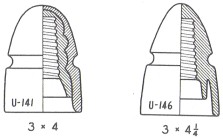
I just received two exciting new reports that should be brought to your
attention. George Nowacki (NIA #5813) from Sudbury, Ontario reported that he has
a mint two-part suspension insulator that he found around the mining country
where he lives. It has the Victor R=oo insulator logo marking and a nice
speckled rust/brown glaze. Except for the marking, it is identical to Bill Rohde’s
insulator (with short split connector ring) shown on page 10 of the May 1995
issue of CJ. George said it was used on a circa 1910 power line to one of the
INCO, Ltd. (International Nickel Co.) mining operations at Sudbury.
Tim SanSoucie (NIA #5129) just reported a very interesting marking
combination on his brown U-152. On one side is the uncommon marking G. P. Co.
and the reverse side has a faint but clear scarce MP marking. I quickly grabbed
my U-152 specimens with MP and G. P. Co. markings for comparison. Indeed, each
specimen matches perfectly with exception of glaze color and wire groove size.
My brown MP specimen has a 3/4" diameter wire groove (my white one has a
5/8" groove) compared to 1/2" for the G. P. Co., and the glaze color
is closer to a light (German) chocolate brown compared to the typical speckled
rust/brown glaze of my G. P. Co. specimen. I do have a G. P. Co. marked
wall-through tube (1-1/2" diameter hole by 3-1/4" tall) with nearly
the same glaze color as my U-152 MP specimen. Of notable similarity is the
unique thin-edged petticoat, lack of collar at start of threads, and 1/2"
diameter, slightly concave impression in top of pinhole. I have no doubt that
the U-152 MP insulators were made by G. P. Co.
MP stands for Missouri Pacific Railroad, and insulators with this marking
were found in Missouri along that railroad. Bob Stahr (NIA #4186) got a few MP
marked insulators from a man in Missouri who said that U-152’s with G. P. Co.
markings were also found on the same line as those marked with MP. Bob says that
it appears that the white MP marked specimens outnumber the brown ones, and that
there is a variety of brown glaze colors. MP marked U-152’s are scarce (Bob
still has a couple left for trade). The only other MP marked style is U-610A. No
one reported having U-610A in the survey (the report of a U-625B should have
been listed under U-610A), but I have since learned of five in collections
including a new addition to my collection. An MP marked U-610A is much more rare
than the U-152.
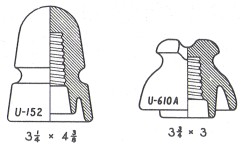
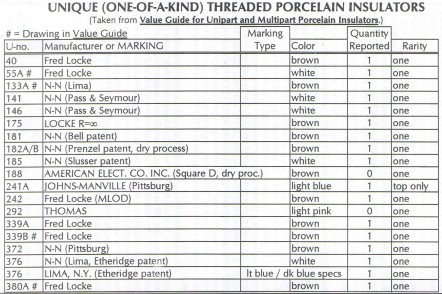
Medium Image (130 Kb)
Large Image (263 Kb)
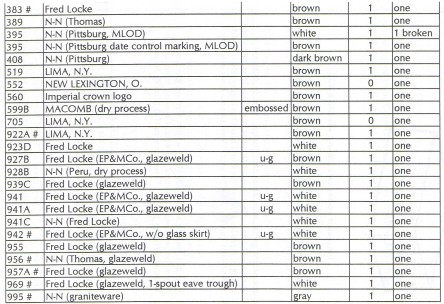
Medium Image (134 Kb)
Large Image (285 Kb)
| 